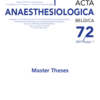Outcome and hospitalization costs after aneurysmal subarachnoid hemorrhage: a single center retrospective analysis
aneurysmal subarachnoid hemorrhage; cost analysis; WFNS; QALY; Critical Care
Published online: Apr 21 2022
Abstract
Aneurysmal subarachnoid hemorrhage (aSAH) has a highly variable clinical outcome. Extended ICU and hospital stay often result in increased healthcare related costs. This study aimed to examine the relationship between aSAH severity, hospital costs and functional outcome in patients who required urgent or semi-urgent endovascular repair.
Patients treated with endovascular repair after ex- periencing aSAH from January 2017 until September 2018 were included in this retrospective single center study. aSAH severity upon admission was classified by the World Federation of Neurosurgical Societies (WFNS) grade, dichotomized into WFNS grade 1-2, ‘low grade aSAH’ and WFNS grade 3-5, ‘high grade aSAH’. Functional outcome was assessed at ICU discharge and 1 year post aSAH by utilizing the modified Rankin Scale (mRS) and converted to quality adjusted life years (QALY) for the latter time point. Healthcare related costs during index hospital stay were analyzed.
A total of 69 patients were included with 44 (63,8%) suffering from low grade aSAH and 25 (36,2%) from high grade aSAH. Median utility scores at 1 year were 0,93 (IQR 0,83-0,93) for low grade aSAH and 0,42 (IQR 0-0,83) for high grade aSAH (p<0,001). Mean total costs were 56.150 euro (IQR 25.572-62.060) in high grade and 26.288 euro (IQR 18.893-29.993) in low grade aSAH (p=0,003). Cost per 0.1 QALY gain in high grade aSAH was 13.233 euro (IQR 2.803-23.072) and higher than in low grade aSAH 3.497 euro (IQR 2.200-3.344) (p=0,027). Short term healthcare related costs strongly depend on aSAH severity. ICU stay and ICU related complications were important cost driving factors.
High grade aSAH is also accompanied by lower functional outcomes at 1 year and decreased cost-effectiveness in comparison to low grade aSAH.
